英语介词用法大全
- 格式:doc
- 大小:50.00 KB
- 文档页数:4

40个英语介词用法总结
40个英语介词用法总结
1. in: 表示在某个地方或时间内,例如:in the park, in the morning
2. on: 表示在某个表面或时间点上,例如:on the table, on Monday
3. at: 表示在某个地点或时刻,例如:at the cinema, at 9 o'clock
4. by: 表示通过某种方式或在某个时间之前,例如:by car, by tomorrow
5. for: 表示为了某个目的或一段时间,例如:for a party, for a week
6. with: 表示伴随或使用某物,例如:with friends, with a pen
7. to: 表示移动到某个地方或给予某人,例如:go to school, give it to me
8. from: 表示起始点或来源,例如:from home, from China
9. into: 表示进入某个地点或状态的转变,例如:jump into the water, turn into a butterfly
10. out: 表示从某地点离开或移动到室外,例如:go out, look out of the window
11. up: 表示向上移动或增加,例如:climb up the stairs,
wake up
12. down: 表示向下移动或减少,例如:walk down the hill, calm down
13. about: 表示关于某事或在某个范围内,例如:talk about the movie, wander about the city

英语介词知识点用法全解英语介词知识点用法总结
1表示方位的介词:in,to, on
1. in 表示在某地X围之内。
如:
Shanghai is/lies in the east of China.
XX在中国的东部。
2. to 表示在某地X围之外。
如:
Japan is/lies to the east of China.
日本位于中国的东面。
3. on 表示与某地相邻或接壤。
如:
Mongolia is/lies on the north of China.
蒙古国位于中国北边。
2表示计量的介词:at, for, by
1. at表示“以……速度”“以……价格”。
如:
It flies at about 900 kilometers an hour.
它以每小时900公里的速度飞行。
I sold my car at a high price.
我以高价出售了我的汽车。
2. for表示“用……交换,以……为代价”。
如:
He sold his car for 500 dollars.
他以五百元把车卖了。
注意:at表示单价(price) ,for表示总钱数。
3. by表示“以……计”,后跟度量单位。如:
They paid him by the month.
他们按月给他计酬。
Here eggs are sold by weight.
在这里鸡蛋是按重量卖的。
3表示材料的介词:of, from, in
1. of成品仍可看出原料。
如:
This box is made of paper.
这个盒子是纸做的。
2. from成品已看不出原料。
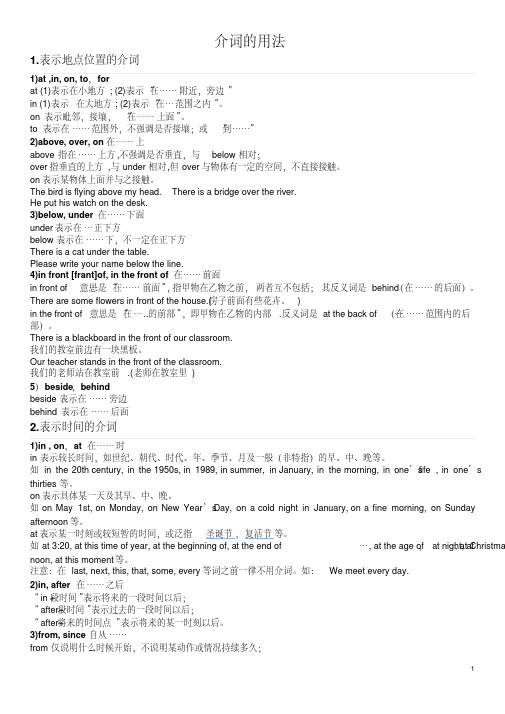
介词的用法
1.表示地点位置的介词
1)at ,in, on, to,for
at (1)表示在小地方; (2)表示“在……附近,旁边”
in (1)表示在大地方; (2)表示“在…范围之内”。
on 表示毗邻,接壤,“在……上面”。
to 表示在……范围外,不强调是否接壤;或“到……”
2)above, over, on 在……上
above 指在……上方,不强调是否垂直,与below相对;
over指垂直的上方,与under相对,但over与物体有一定的空间,不直接接触。
on表示某物体上面并与之接触。
The bird is flying above my head. There is a bridge over the river.
He put his watch on the desk.
3)below, under 在……下面
under表示在…正下方
below表示在……下,不一定在正下方
There is a cat under the table.
Please write your name below the line.
4)in front [frant]of, in the front of在……前面
意思是“在……前面”,指甲物在乙物之前,两者互不包括;其反义词是behind(在……的后面)。
in front of…
There are some flowers in front of the house.(房子前面有些花卉。)
in the front of 意思是“在…..的前部”,即甲物在乙物的内部.反义词是at the back of…
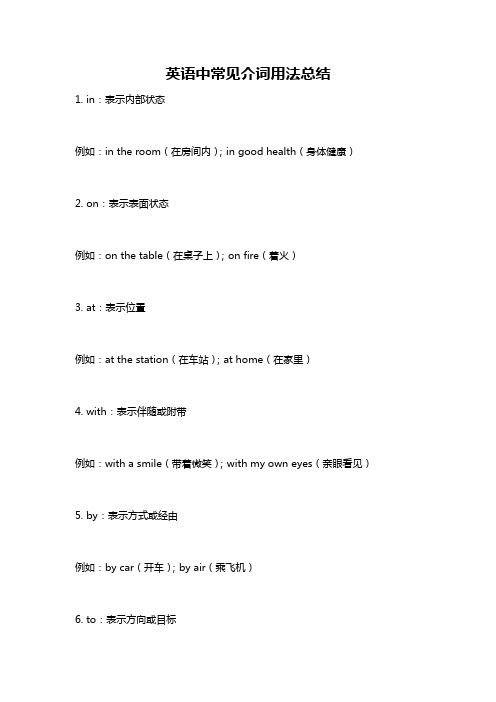
英语中常见介词用法总结
1. in:表示内部状态
例如:in the room(在房间内);in good health(身体健康)2. on:表示表面状态
例如:on the table(在桌子上);on fire(着火)
3. at:表示位置
例如:at the station(在车站);at home(在家里)
4. with:表示伴随或附带
例如:with a smile(带着微笑);with my own eyes(亲眼看见)5. by:表示方式或经由
例如:by car(开车);by air(乘飞机)
6. to:表示方向或目标
例如:to the park(去公园);to the moon(到月球)
7. from:表示出发地或来源
例如:from Beijing(来自北京);from the magazine(从杂志中)
8. for:表示目的或用途
例如:for a birthday party(为了生日派对);for writing(用于写作)
9. of:表示属于或关系
例如:the book of Harry Potter(哈利·波特的书);the sister of Mary(玛丽的姐姐)
10. with:表示具有或伴随
例如:a man with a gun(拿着枪的人);a girl with long hair(长发女孩)
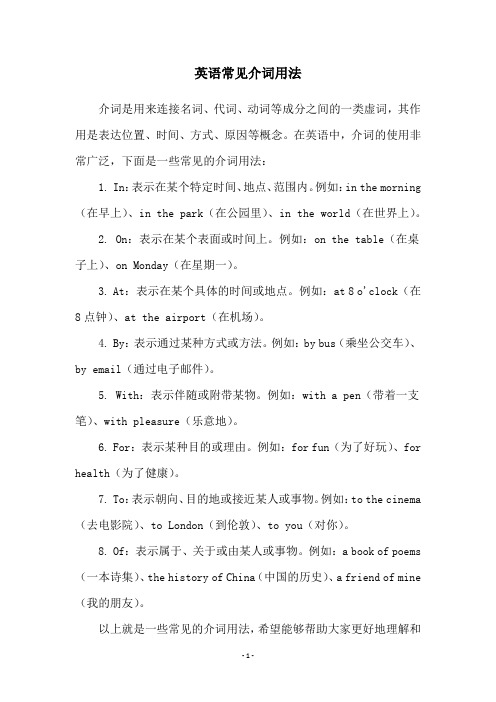
英语常见介词用法
介词是用来连接名词、代词、动词等成分之间的一类虚词,其作用是表达位置、时间、方式、原因等概念。在英语中,介词的使用非常广泛,下面是一些常见的介词用法:
1. In:表示在某个特定时间、地点、范围内。例如:in the morning (在早上)、in the park(在公园里)、in the world(在世界上)。
2. On:表示在某个表面或时间上。例如:on the table(在桌子上)、on Monday(在星期一)。
3. At:表示在某个具体的时间或地点。例如:at 8 o'clock(在8点钟)、at the airport(在机场)。
4. By:表示通过某种方式或方法。例如:by bus(乘坐公交车)、by email(通过电子邮件)。
5. With:表示伴随或附带某物。例如:with a pen(带着一支笔)、with pleasure(乐意地)。
6. For:表示某种目的或理由。例如:for fun(为了好玩)、for health(为了健康)。
7. To:表示朝向、目的地或接近某人或事物。例如:to the cinema (去电影院)、to London(到伦敦)、to you(对你)。
8. Of:表示属于、关于或由某人或事物。例如:a book of poems (一本诗集)、the history of China(中国的历史)、a friend of mine (我的朋友)。
以上就是一些常见的介词用法,希望能够帮助大家更好地理解和
掌握英语介词的使用。
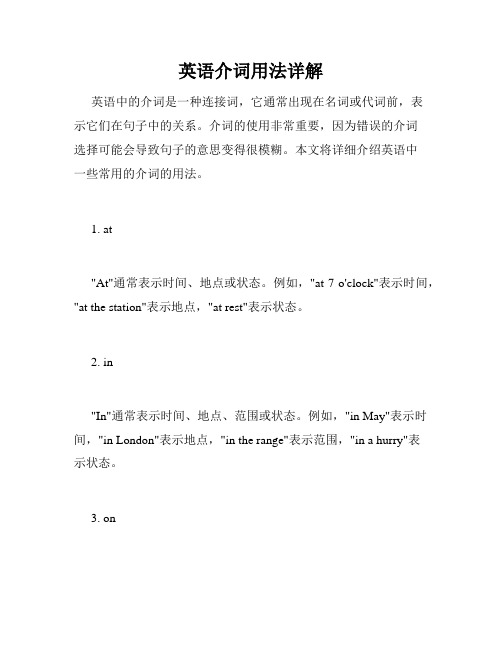
英语介词用法详解
英语中的介词是一种连接词,它通常出现在名词或代词前,表
示它们在句子中的关系。介词的使用非常重要,因为错误的介词
选择可能会导致句子的意思变得很模糊。本文将详细介绍英语中
一些常用的介词的用法。
1. at
"At"通常表示时间、地点或状态。例如,"at 7 o'clock"表示时间,"at the station"表示地点,"at rest"表示状态。
2. in
"In"通常表示时间、地点、范围或状态。例如,"in May"表示时间,"in London"表示地点,"in the range"表示范围,"in a hurry"表
示状态。
3. on
"On"通常表示时间、地点、表面或状态。例如,"on Monday"
表示时间,"on the table"表示地点,"on the surface"表示表面,"on fire"表示状态。
4. to
"To"通常表示方向、目的地或比较。例如,"go to the park"表示方向,"fly to Paris"表示目的地,"superior to"表示比较。
5. with
"With"通常表示伴随、带有或使用。例如,"with a friend"表示
伴随,"apple with a worm"表示带有,"write with a pen"表示使用。
6. from
"From"通常表示出发地、来源或区别。例如,"from New York"
表示出发地,"from the north"表示来源,"different from"表示区别。
7. for
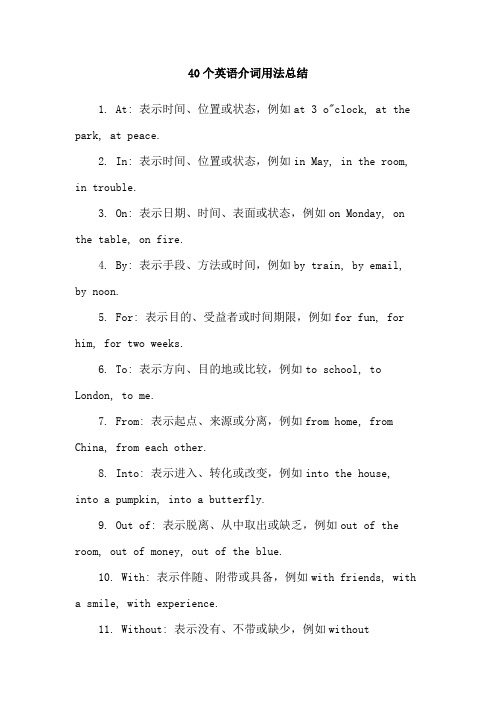
40个英语介词用法总结
1. At: 表示时间、位置或状态,例如at 3 o"clock, at the park, at peace.
2. In: 表示时间、位置或状态,例如in May, in the room, in trouble.
3. On: 表示日期、时间、表面或状态,例如on Monday, on the table, on fire.
4. By: 表示手段、方法或时间,例如by train, by email, by noon.
5. For: 表示目的、受益者或时间期限,例如for fun, for him, for two weeks.
6. To: 表示方向、目的地或比较,例如to school, to London, to me.
7. From: 表示起点、来源或分离,例如from home, from China, from each other.
8. Into: 表示进入、转化或改变,例如into the house,
into a pumpkin, into a butterfly.
9. Out of: 表示脱离、从中取出或缺乏,例如out of the room, out of money, out of the blue.
10. With: 表示伴随、附带或具备,例如with friends, with
a smile, with experience.
11. Without: 表示没有、不带或缺少,例如without
permission, without shoes, without doubt.

常见的英语介词有:in,on,with,by,for,at,about,under,of,to 等。
in作介词时意为“在……内;进……里;在……位置;在……期间;在……以后;穿着(后一般跟颜色);在……状态中;在……方面;包含在……中;从事……;用……语言,以……媒介;以……调;在(活动)过程中;在……岁数;当……时;(引出具某种品质的人的名字);占……;在……之中(用于较大和较小数字之间);以……的数量;带……颜色的;以……方式;具有……特性;按照(表示方式)”。
例句:
Have you like images in this?
有你们喜欢的偶像在这吗?
on作介词时意为“在……之上;向,朝;关于;在……时候;由……支撑;(身上)带着;一……就;吃,喝;接近;根据;挣……钱;以……支付;以……为燃料;在……中;作为……成员;借助(仪器或器械);与……相比;增加;靠……服用药物;(由电台或电视)播放;忙碌于”。
例句:
I have to disagree with you on this.
在这件事情上我不同意你的看法。
with作介词时意为“和……在一起;具有;用;反对;关于;包括;由于;随着;顺着;受雇于;虽然;支持;穿着;受……影响;表示与某物分离;由……负责”。
例句:
I am one with you on this.
在这一点上,我和你的意见是一致的。
by作介词时意思是“由,被;通过;相差……;到……之前;在……旁边”。例句:
The telephone is by the window.

英语介词用法最全总结
英语介词是学习英语语法中非常重要的一部分,它们在句子中起着连接词的作用,指示名词、代词或动词与其他词之间的关系。正确地使用介词可以使句子更加生动、准确,并且对于掌握英语的表达能力至关重要。下面将为大家总结英语中常见的介词用法。
1. 位置(Location)
介词在描述位置时非常常用。例如,在描述位置关系时可以使用"in"、"on"、"under"、"beside"、"in front of" 等。比如:The book is on the table(书在桌子上)。
2. 时间(Time)
表达时间关系时,介词也是必不可少的。例如,在描述时间时可以使用 "at"、"in"、"on"、"during"、"for" 等。比如:I will meet you at 7 o'clock(我会在7点见你)。
3. 方式(Manner)
介词在描述方式时的使用较为灵活。比如:She walked with confidence(她自信地走着)。
4. 原因(Cause)
介词可以用于表达原因。比如:They canceled the trip due to bad weather(由于天气恶劣,他们取消了旅行)。
5. 目的(Purpose)
介词也能表达目的。比如:He went to the store to buy some groceries (他去商店买些食品)。
6. 所属关系(Possession)
介词可以用于表达所属关系。比如:This book belongs to me(这本书是我的)。
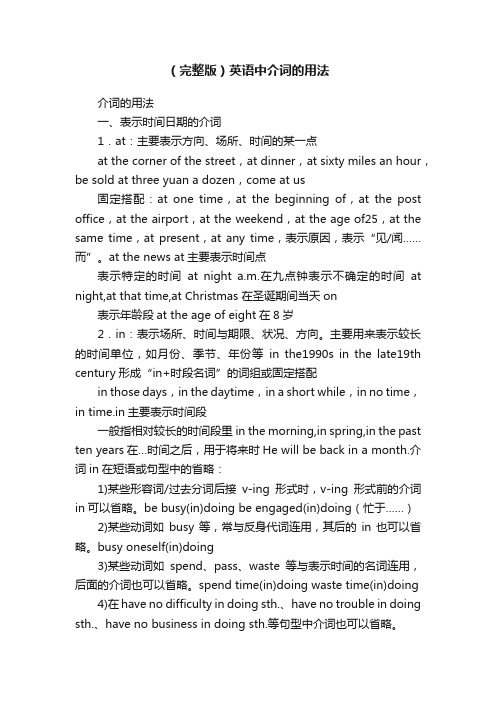
(完整版)英语中介词的用法
介词的用法
一、表示时间日期的介词
1.at:主要表示方向、场所、时间的某一点
at the corner of the street,at dinner,at sixty miles an hour,be sold at three yuan a dozen,come at us
固定搭配:at one time,at the beginning of,at the post office,at the airport,at the weekend,at the age of25,at the same time,at present,at any time,表示原因,表示“见/闻……而”。at the news at主要表示时间点
表示特定的时间at night a.m.在九点钟表示不确定的时间at night,at that time,at Christmas 在圣诞期间当天on
表示年龄段at the age of eight在8岁
2.in:表示场所、时间与期限、状况、方向。主要用来表示较长的时间单位,如月份、季节、年份等in the1990s in the late19th century形成“in+时段名词”的词组或固定搭配
in those days,in the daytime,in a short while,in no time,in time.in主要表示时间段
一般指相对较长的时间段里in the morning,in spring,in the past ten years在…时间之后,用于将来时He will be back in a month.介词in在短语或句型中的省略:
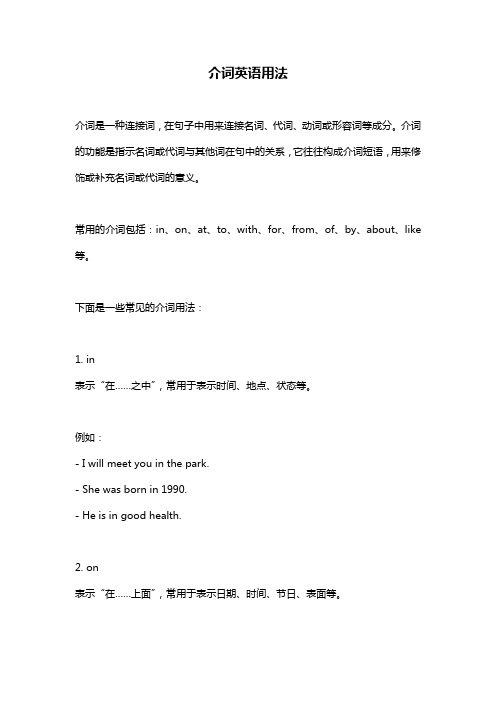
介词英语用法
介词是一种连接词,在句子中用来连接名词、代词、动词或形容词等成分。介词的功能是指示名词或代词与其他词在句中的关系,它往往构成介词短语,用来修饰或补充名词或代词的意义。
常用的介词包括:in、on、at、to、with、for、from、of、by、about、like 等。
下面是一些常见的介词用法:
1. in
表示“在……之中”,常用于表示时间、地点、状态等。
例如:
- I will meet you in the park.
- She was born in 1990.
- He is in good health.
2. on
表示“在……上面”,常用于表示日期、时间、节日、表面等。
例如:
- The book is on the table.
- We will have a party on Christmas Day.
- I usually go to bed on time.
3. at
表示“在……的地点、时间或情况”,常用于表示时间、地点、活动等。
例如:
- We will meet at the station at 7 o'clock.
- He is good at playing basketball.
- I am at home now.
4. to
表示“到达”,常用于表示动作的方向。
例如:
- I am going to the store.
- He went to the park to play basketball.
- She is walking to the school.

英语常用介词及用法
英语中常用的介词包括:
1. in:表示时间、地点、状态等,常用于表示时间范围、在某个地点、处于某种状态等,如in the morning(早上)、in London(在伦敦)、in love(恋爱中)等。
2. on:表示时间、地点、状态等,常用于表示在某一时间、在某个
表面等,如on Monday(星期一)、on the table(在桌子上)、on
fire(着火)等。
3. at:表示时间、地点、状态等,常用于表示在某个时间点、在某
个位置等,如at 3 o'clock(3点钟)、at home(在家)、at a party (在一个聚会上)等。
4. to:表示方向、目的等,常用于表示朝着某个方向、去某个地方、目的是什么等,如go to school(去学校)、the road to success(通
向成功的道路)等。
5. with:表示伴随、带有等,常用于表示和谁在一起、带有什么等,如go with friends(和朋友一起去)、a book with pictures(带有图
片的书)等。
6. for:表示目的、代替等,常用于表示为了什么目的、代替什么等,如study for the exam(为考试而学习)、this is for you(这是给你的)等。
7. by:表示方式、经由等,常用于表示通过什么方式、经由什么途
径等,如travel by plane(乘坐飞机旅行)、by myself(独自)等。
8. of:表示所属、材料等,常用于表示属于什么、由什么材料等,如the book of John(约翰的书)、a cup of tea(一杯茶)等。

英语句子中介词的使用技巧
1. 使用介词来表示地点或方向:on, at, in, to, from, into等。例如:I live in New York.(我住在纽约。)
2. 使用介词来表示时间:in, on, at等。例如:I will see you in the morning.(我早上会见你。)
3. 使用介词来表示原因或目的:because of, due to, for等。例如:She didn't come to the party because of her illness.(她因为生病没有来参加聚会。)
4. 使用介词来表示关系或属性:of, with, about, by等。例如:This book is about history.(这本书是关于历史的。)
5. 使用介词来表示方式或手段:by, with, through等。例如:He won the race by running fast.(他通过跑得快赢得了比赛。)
6. 使用介词来表示条件或假设:if, unless, provided等。例如:I will go to the picnic if the weather is good.(如果天气好,我会去野餐。)
7. 使用介词来表示比较或对比:like, unlike, than等。例如:She is taller than her sister.(她比她妹妹高。)
8. 使用介词来表示目标或目的地:to, towards, for等。例如:I am going to the supermarket to buy some groceries.(我要去超市买些食品杂货。)
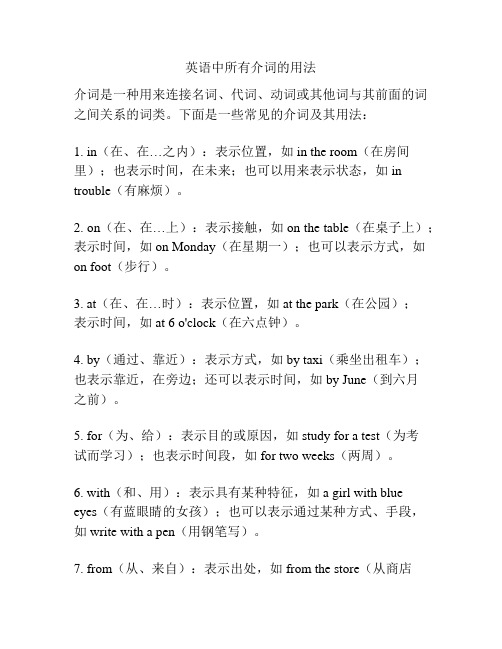
英语中所有介词的用法
介词是一种用来连接名词、代词、动词或其他词与其前面的词之间关系的词类。下面是一些常见的介词及其用法:
1. in(在、在…之内):表示位置,如in the room(在房间里);也表示时间,在未来;也可以用来表示状态,如in trouble(有麻烦)。
2. on(在、在…上):表示接触,如on the table(在桌子上);表示时间,如on Monday(在星期一);也可以表示方式,如on foot(步行)。
3. at(在、在…时):表示位置,如at the park(在公园);
表示时间,如at 6 o'clock(在六点钟)。
4. by(通过、靠近):表示方式,如by taxi(乘坐出租车);也表示靠近,在旁边;还可以表示时间,如by June(到六月
之前)。
5. for(为、给):表示目的或原因,如study for a test(为考
试而学习);也表示时间段,如for two weeks(两周)。
6. with(和、用):表示具有某种特征,如a girl with blue
eyes(有蓝眼睛的女孩);也可以表示通过某种方式、手段,
如write with a pen(用钢笔写)。
7. from(从、来自):表示出处,如from the store(从商店
里);表示起点,如from London(从伦敦)。
8. to(到、向):表示目的地,如go to school(去学校);表示方向,如face to the north(面朝北方)。
这只是一部分介词的使用方法,介词的用法还有很多,需要根据具体语境来理解和运用。

英语介词用法
英语介词是一种虚词,用于连接名词、代词或其他词类与句子中的其他成分。它们在句子中起到了连接和修饰的作用,使句子更加准确、清晰。以下是一些常见的英语介词用法:
1. 表示时间:at(在某一时刻)、in(在某一段时间内)、on (在某一天或特定日期)、by(在某一特定时间之前)、for(持续一段时间)等。
2. 表示地点:at(在某一具体地点)、in(在某一范围内)、on(在某一表面上)、under(在某一物体下面)、behind(在某一物体后面)等。
3. 表示方向:to(朝着某一方向)、from(来自某一地方)、through(穿过某一空间)、along(沿着某一路径)等。
4. 表示原因:for(由于)、because of(因为)、due to(由于)等。
5. 表示目的:for(为了)、to(为了)等。
6. 表示方式:by(通过某种方式)、with(用某种工具或手段)等。
7. 表示比较:like(像)、as(像……一样)、than(比)等。
需要注意的是,英语介词的用法比较复杂,需要根据具体语境和
句子结构来判断使用哪一个介词。在学习和使用介词时,需要多读多练,逐渐掌握其用法。

45个常见介词的基本用法
介词短语=介词+名词
1、about
基本含义:a-b-out “A在B外面”
引申含义:“A和B的联系”
1、在…周围:The kids are sitting about their teacher.
I like the necklace about her throat.
2、环绕:The bird always flies about the forest.
I plan to travel about the world.
3、关于:a book about English study
They are talking about the new film.
4、adv 大约
固定搭配:
1、How about...
2、something+adj+about X
一些关于X的adj的事
2、above
基本含义:a-b-over “A在B上方”
引申含义:
1、在…上方:The sun rose above the horizon.
2、数目大于…/重量超过…/价格能力、地位高于…
There is nothing in the store above 50 cents.
“He who comes after me is above me ;because he was before me”
固定搭配:
1、above all: 首先强调重要性
Above all; he was an outstanding mathematician.
2、above all things:最最…
What you need; above all things; is confidence.